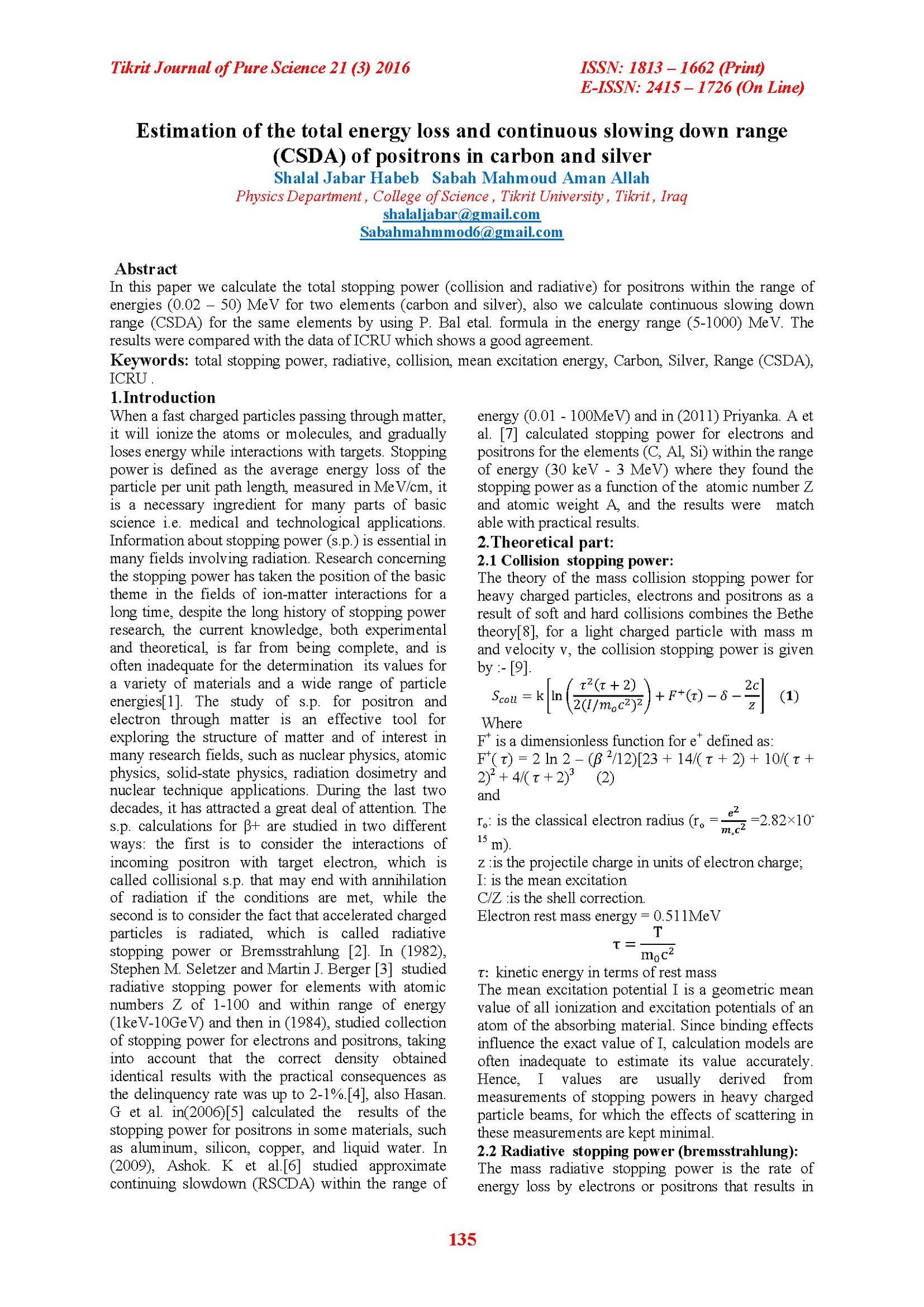Estimation of the total energy loss and continuous slowing down range (CSDA) of positrons in carbon and silver
Main Article Content
Abstract
In this paper we calculate the total stopping power (collision and radiative) for positrons within the range of energies (0.02 – 50) MeV for two elements (carbon and silver), also we calculate continuous slowing down range (CSDA) for the same elements by using P. Bal etal. formula in the energy range (5-1000) MeV. The results were compared with the data of ICRU which shows a good agreement.
Article Details

This work is licensed under a Creative Commons Attribution 4.0 International License.
Tikrit Journal of Pure Science is licensed under the Creative Commons Attribution 4.0 International License, which allows users to copy, create extracts, abstracts, and new works from the article, alter and revise the article, and make commercial use of the article (including reuse and/or resale of the article by commercial entities), provided the user gives appropriate credit (with a link to the formal publication through the relevant DOI), provides a link to the license, indicates if changes were made, and the licensor is not represented as endorsing the use made of the work. The authors hold the copyright for their published work on the Tikrit J. Pure Sci. website, while Tikrit J. Pure Sci. is responsible for appreciate citation of their work, which is released under CC-BY-4.0, enabling the unrestricted use, distribution, and reproduction of an article in any medium, provided that the original work is properly cited.
References
[1] Hemalata Singh, S. K. Rathi1, A. S. Verma”, 2013. Stopping Powers of Protons in Biological Human Body Substances” Universal Journal of Medical Science 1(2): 17-22.
[2] W. H. Bragg and R. Kleeman, Philos. Mag., 10, 318 (1905).
[3] STEPHEN M. SELTZER and MARTIN J. BERGER, "Procedure for Calculating the Radiation Stopping Power for Electrons",Int. J. AppL Radiat. Isot. Vol. 33. P.P. 1219 - 1226. (1982).
[4] STEPHEN M. SELTZER and MARTIN J. BERGER, "Improved Procedure for Calculating the Collision Stopping Power of Elements and Compounds for Electrons and Positrons", Int. J. Appl. Radiat. lsot. P.P. 665-676,Vol. 35, No, 7,(1984 ).
[5] Hasan Gumu¸ s, Onder Kabaday, and M. C¸ agatay Tufan "Calculation of the Stopping Power for Intermediate Energy Positrons "CHINESE JOURNAL OF PHYSICS VOL. 44, NO.4(2006).
[6] A. Kumar, B. Salaria, S. Singh, Balkrishan, C. haranjeet Singh, and G. S. Mudahar, "Study of CSDA
and Extrapolated Ranges of Electrons in some Selected Solvents in the Energy Range of 0.01-100 MeV", Asian Journal of Chemistry, Vol.21, No.10, p.p 130-134, (2009).
[7] Priyanka Agrawal, S. K. Rathi and A. S. Verma ,"Stopping power of carbon, aluminum and silicon for electrons and positrons ", Priyanka Agarwal et al./ Elixir Chem. Phys. 37, P.P 3856-3859, (2011).
[8] H.A. Bethe, Ann. Physik 5 (1930) 325–400.
[9] R. D. Evans, (1955). The Atomic Nucleus, McGraw-Hill; reprinted , R. E. Krieger, Malabar
[10] H. Bethe and W. Heitler, Proc. R Soc. London Ser. A 146, 83 (1934).
[11] J. Berger and S. M. Seltzer, National Bureau of Standards NBSIR 82-2550-A (1982).
[12] ICRU, International Commission Radiation Units and Measurements, 7910 Wood mont Ave. "Stopping powers for electrons and positrons", Report 37, Bethesda MD 20814(1984).
[13] W. Koch and J. W. Motz, Rev. Mod. Phys. 31, 29 (1959).
[14] W. H. Bragg and R. Kleeman, Philos. Mag., 10, 318 (1905)
[15] J. Berger and S. M. Seltzer, NASA Publication SP-3012 (1964).
[16] K. Batra and M. L. Sehgal, Nucl. Instrum. Methods 109, 566 (1973).
[17] K. Gupta and D. K. Gupta, Ind. J. Appl. Phys. 17, 775 (1979).
[18] J. Bhabha, Proc. R. Soc. London Ser. A 154,195 (1936).
[19] Rohr1ich and B. C. Carlson, Phys. Rev. 93, 38 (1953).
[20] Bichsel, H.(1968). Charged particle interactions. Chap 4 in Radiation Dosimetry, 2nd ed.,Vol. I (F. H. Attix and W. C. Roesch, eds.), Academic Press, New York.
[21] H.A. Bethe. g. Ashkin "Passage of radiation through matter in experimental physics " Vol. l ed.by E .serg (John wiley & Sons , Newyorke) USA (1993).
[22] William R. Leo "Techniques for nuclear and particle physics "ch.2, p.p 99-110, springe’s – Verlag, Germany (1987).
